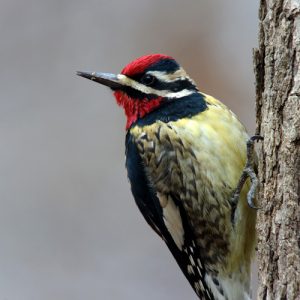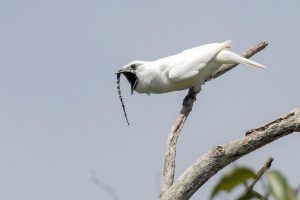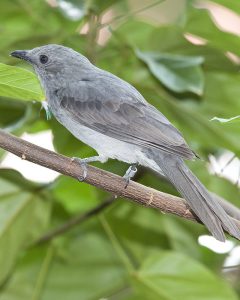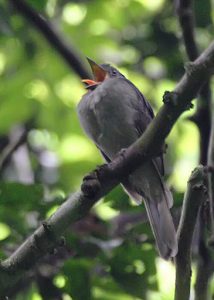Podcast: Play in new window | Download (Duration: 8:55 — 8.7MB)
I still have a cold, so let’s let some birds do part of the talking in this episode about more weird bird calls!
Further reading:
Listen to the Loudest Bird Ever Recorded
Further listening/watching:
A video of the screaming piha. You need to see this.
The yellow-bellied sapsucker is a real bird, and an adorable one too:

The mute swan is not actually mute:

The white bellbird is the loudest bird ever recorded (photo by Anselmo d’Affonseca):

The screaming piha is hilariously loud. Left, sitting like a normal bird. Right, screaming:


Show transcript:
Welcome to Strange Animals Podcast. I’m your host, Kate Shaw.
I still have this rotten cold, although I’m getting over it. As you can hear, my voice is pretty messed up, so for this episode I’ll let birds do some of the talking for me. Yes, it’s another weird bird calls episode!
We’ll start with this cute little call:
[yellow-bellied sapsucker call]
That’s not a dog’s squeaky toy, it’s a yellow-bellied sapsucker. Yes, that’s a real bird. It’s a type of woodpecker that lives in much of eastern and northern North America, breeding in Canada and spending winters in the eastern United States and Mexico. I get them in my yard sometimes. The sapsucker will also drum on dead trees and other items to make a loud sound to communicate with other sapsuckers.
It mostly eats tree sap, but it also eats berries, small insects, and fruit. To get the tree sap, it drills small holes in tree bark, usually in neat rows, and licks up the sap that oozes from the holes. If you ever see a tree with rows of little holes in the bark, that was done by a sapsucker. It can sometimes even kill trees this way, but for the most part it doesn’t hurt the tree unless the tree is already dying.
Males and females both forage for insects to feed their babies. They usually dip the insects in tree sap before feeding them to the chicks. Yummy!
Next up is this little grunty call:
[mute swan call]
Maybe it’s not exciting or loud, but it’s made by a bird you wouldn’t expect to hear, the mute swan. I mean, the word mute is right there in its name but it’s not mute at all. The mute swan is a big white waterfowl from Eurasia, although it’s been introduced to other parts of the world since it’s so pretty. Its legs are black with an orange and black bill, and it has a long neck that it uses to reach plants that are deeper underwater than ducks and most geese can get at. Its wingspan can be seven and a half feet across, or 2.4 meters. It’s more closely related to the black swan of Australia and the black-necked swan of South America than it is to other swan species from Eurasia.
Mute swans get their name not because they can’t make sounds, obviously, but because they’re not as noisy as other swan species. Not only does it make the little grunting sounds we just heard, it will sometimes hiss aggressively if a person or animal gets too close to its nest. Also, swans can give you such a wallop with their wings that they could knock you out stone cold, so it’s best to just watch them from a distance and not get too close. When mute swans fly, their wings make a distinctive thrumming sound that helps them stay in contact with other mute swans. This is what their wingbeats sound like:
[mute swans flying]
That sounds more like a UFO than a bird, just saying.
Next is a weird metallic call that doesn’t sound like a noise a bird could make either. It sounds like an industrial machine of some kind:
[white bellbird call]
That’s the sound the male white bellbird gives to attract a female. It also happens to be the loudest bird call ever recorded. In late 2018, an ornithologist from Brazil teamed up with a bioacoustician from the United States. They traveled into the mountainous forests of the Brazilian Amazon to record both the white bellbird and our next bird, which I’ll get to in a minute.
The male white bellbird is white with a black bill with a long wattle hanging from it. The female is green streaked with brown. It’s about the size of a pigeon but the male is as loud as a piledriver hammering rock. The male sits on an exposed perch to call, usually the top of a tree. If a female is interested, she’ll join him. The male will turn his back on the female, then turn around quickly to face her during the call, which adds an extra level of drama to an already dramatic call. These birds are the rock stars of the bird world.
The white bellbird eats fruit, some of it rather large, so the bird can open its beak really wide. This makes its beak act as the bell of an instrument like a trumpet, which helps increase the volume of its call. It also has a robust syrinx and unusually strong abdominal muscles. Its call can reach 125 decibels, which is louder than a firetruck’s siren, a rock band, and even a thunderclap.
Let’s finish with another extremely loud bird:
[screaming piha call]
That’s the male screaming piha, which is related to the white bellbird and lives in the same areas in South America. It’s a drab-looking bird, plain grayish in color, and it looks like a type of thrush. It’s a little bit bigger than an American robin. But drab as it is, keep in mind the bird has “screaming” right in its name. It’s almost as loud as the white bellbird.
The screaming piha eats fruit and insects, and it especially likes figs, which it often swallows whole. I like figs too but I chew them. Also, I don’t scream to attract a mate. The male usually perches in a tree and starts with a couple of relatively ordinary-sounding notes. But when he does the actual screaming part, he tips backwards on his perch, pulls his head back into his shoulders, so to speak, opens his beak wide to show how orange it is inside, and SCREAMS. It’s hilarious to watch. I’ve linked to a video in the show notes and you really do owe it to yourself to give it a watch.
The male gives these calls to attract a female, but it’s also useful to define his territory to other males. During mating season the males gather in a group called a lek to show off for females, and then pairs return to the male’s territory to build a nest. We don’t know a whole lot about the bird’s nesting behavior, but they appear to only lay one egg. Fortunately the screaming piha is a common bird that’s doing well, because if you’ve watched that video of one screaming you’ll agree that it’s probably the funniest bird ever and we definitely need them in the world.
You can find Strange Animals Podcast online at strangeanimalspodcast.blubrry.net. That’s blueberry without any E’s. If you have questions, comments, or suggestions for future episodes, email us at strangeanimalspodcast@gmail.com. We also have a Patreon if you’d like to support us that way.
Thanks for listening!